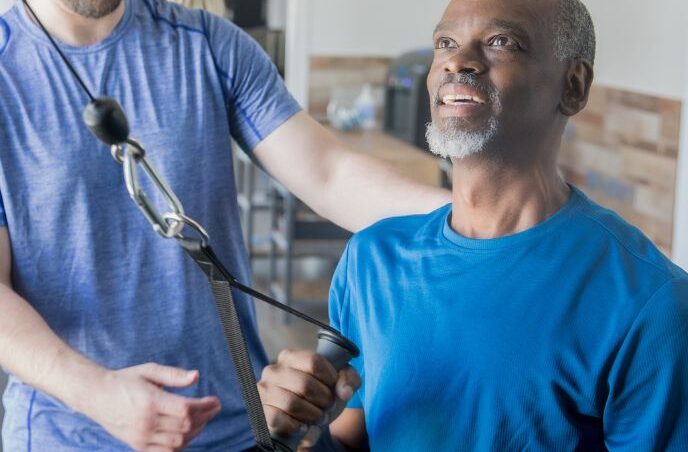Strength Training Benefits For Healthy Bodies
Most of us want to live long, healthy lives. We want to age gracefully and embrace life to its fullest. There are many approaches to slowing aging, but strength training is one of the best gifts you can give your body to keep it feeling strong and healthy into old age.
Why Strength Training is Important for Healthy Aging
Lifting weights can be helpful at any age. For older people, it’s an excellent way to counter some of the physical changes that occur as we age. This includes a decreased range of motion (approximately 6 degrees per decade past age 55), decreased balance, and declining muscle mass ( around 3-8% per decade after age 30). [1] [2]

Are you concerned about the increased frailty, loss of mobility, and other unwanted physical consequences of aging?
Here’s how implementing strength training as part of your prevention routine can help:
Strength Training Helps Prevent Obesity in Aging People
Strength training (when paired with proper nutrition) can be a great way to deal with obesity among older adults.
In a study published in the New England Journal of Medicine, researchers found that practicing weight-lifting exercises yielded better results for older adults with obesity than aerobic exercises. [3] Other animal and human studies further show that weight training helps improve the body composition of aging bodies. [4] [5]
Strength Training Helps Increase Muscle Mass
As mentioned earlier, loss of muscle and declining strength are hallmarks of aging. This phenomenon is known as sarcopenia—a type of muscle atrophy (loss of muscle tissue) that affects people as they age. It is typically caused by a decrease in the number and size of muscle fibers.
According to a journal article published in Age and Ageing, muscle atrophy due to old age increases the risk of falls. The condition is associated with mobility disorders, respiratory disease, cardiac disease, cognitive impairment, and lowered quality of life. [6]
However, you can counter the negative effects of age-related muscle atrophy by building more muscle through strength training. One 2019 study published in the Journal of Aging found that the right functional weight training routine can help combat muscle disuse and reduce negative changes arising from old age. [7]
Another study in Physiological Reviews suggested that older adults could increase muscle mass and strength by as much as 30% by implementing a training program. [8] Stronger muscles lead to improved mobility, balance, and daily function. Reaching for things, playing with your grandchild, or simply sitting down became much easier in your old age.
Increase Bone Density in Aging Bodies
Older people are at an increased risk of falling and fractures. Research shows that strength or resistance training is a promising preventative and therapeutic intervention to curb deteriorating bone health. [9] Exercise helps increase bone density and lower your risk of developing osteoporosis.
Strength Training Lowers the Risk of Disease
Performing strength training a few days every week is associated with a lower risk of disease and improved health outcomes.
According to a 2022 study in the British Journal of Sports Medicine, muscle-strengthening activities were associated with a reduced risk of major non-communicable diseases and all-cause mortality. [10] This includes the risk of total cancer, diabetes, and cardiovascular disease.
Ready to Include Weight Training into Your Health Routine?
Research shows that strength training may be key to healthy aging. However, it may seem intimidating and risky—especially if you have never lifted weights before. The good news is that you can easily and safely start a strength training routine with a few guidelines.
Strength Training Routine and Safety
One of the most important tips for weight training among older people is the need to take it slow. Do not push your body too far or too fast. It would help if you also give your muscles enough time to recuperate between training sessions.
In an article published in The Journal of Strength and Conditioning Research, the National Strength and Conditioning Association (NSCA) reports that a resistance training program for older adults should include 2-3 sessions in a week, separated by at least one day of rest. [11]
Consider starting with 2 days of exercise using relatively light weights. You can add weights and sessions gradually as you get used to strength training.
Examples of Strength Training Exercises for Healthy Aging
According to the Physical Activity Guidelines for Americans by the Department of Health and Human Services (HHS), weight training exercises for older adults should target all major muscle groups. [12] This means that it’s advisable to engage your shoulders, legs, hips, chest, back, arms, and abdomen. Hitting all of these areas should improve your strength and mobility—making it easier to carry out your daily activities.
Several strength training exercises hit these recommended areas. If you have access to a gym, you can create a routine using machine exercises like back extensions, trunk curls, seated rows, chest presses, or leg presses.
Alternatively, you can train using your body weight, free weights, or equipment like kettlebells, resistance bands, dumbbells, and a barbell. Some great bodyweight strength training exercises for healthy aging include squats, push-ups, lateral raises, dumbbell chest presses, and crunches.
Regardless of the type of strength training exercise you choose, make sure you are consistent with your routine. The more consistent you are, the better the results and health benefits you will experience. It is also advisable to pair strength training with stretching activities to improve your mobility and flexibility.
Finally, consider getting a trainer to offer expert guidance on proper form and safety measures. This may help improve your results and reduce the risk of injuries.

Conclusion
Aging may be inevitable, but you can slow down the process to improve your healthspan and quality of life by maintaining healthy lifestyle habits such as strength training.
Committing to a strength training program can be a considerable step toward delaying or preventing the onset of health issues associated with age, including muscle atrophy, deteriorating bone health, and age-related diseases. Strength training allows you to feel and look better as you grow older.
Remember to set realistic goals, be consistent, and adjust your routine to reflect your progress and health. You should also prioritize safety by taking time to master proper form and knowing your limits. Understand that a 30-year-old body is different from a 50-year-old body.
References
- Stathokostas, L., McDonald, M. W., Little, R., & Paterson, D. H. (2013). The flexibility of older adults aged 55–86 years and the influence of physical activity. Journal of aging research, 2013.
- Volpi, E., Nazemi, R., & Fujita, S. (2004). Muscle tissue changes with aging. Current opinion in clinical nutrition and metabolic care, 7(4), 405.
- Villareal, D. T., Chode, S., Parimi, N., Sinacore, D. R., Hilton, T., Armamento-Villareal, R., … & Shah, K. (2011). Weight loss, exercise, or both, and physical function in obese older adults. New England Journal of Medicine, 364(13), 1218-1229.
- Thirupathi, A., da Silva Pieri, B. L., Queiroz, J. A. M. P., Rodrigues, M. S., de Bem Silveira, G., de Souza, D. R., … & De Souza, C. T. (2019). Strength training and aerobic exercise alter mitochondrial parameters in brown adipose tissue and equally reduce body adiposity in aged rats. Journal of physiology and biochemistry, 75(1), 101-108.
- Cunha, P. M., Ribeiro, A. S., Tomeleri, C. M., Schoenfeld, B. J., Silva, A. M., Souza, M. F., … & Cyrino, E. S. (2018). The effects of resistance training volume on osteosarcopenic obesity in older women. Journal of sports sciences, 36(14), 1564-1571.
- Cruz-Jentoft, A. J., Bahat, G., Bauer, J., Boirie, Y., Bruyère, O., Cederholm, T., … & Zamboni, M. (2019). Sarcopenia: revised European consensus on definition and diagnosis. Age and aging, 48(1), 16-31.
- Resende-Neto, A. D., & Da Silva-Grigoletto, M. E. (2019). Prescription of the functional strength training for older people: a brief review. Aging Sci, 7, 210.
- Larsson, L., Degens, H., Li, M., Salviati, L., Lee, Y. I., Thompson, W., … & Sandri, M. (2019). Sarcopenia: aging-related loss of muscle mass and function. Physiological reviews, 99(1), 427-511.
- Hong, A. R., & Kim, S. W. (2018). Effects of resistance exercise on bone health. Endocrinology and Metabolism, 33(4), 435-444.
- Momma, H., Kawakami, R., Honda, T., & Sawada, S. S. (2022). Muscle-strengthening activities are associated with lower risk and mortality in major non-communicable diseases: a systematic review and meta-analysis of cohort studies. British Journal of Sports Medicine.
- Fragala, M. S., Cadore, E. L., Dorgo, S., Izquierdo, M., Kraemer, W. J., Peterson, M. D., & Ryan, E. D. (2019). Resistance training for older adults: a position statement from the national strength and conditioning association. The Journal of Strength & Conditioning Research, 33(8).
- Physical Activity Guidelines for Americans (The U.S. Department of Health and Human Services): https://health.gov/sites/default/files/2019-09/Physical_Activity_Guidelines_2nd_edition.pdf






Leave a Reply